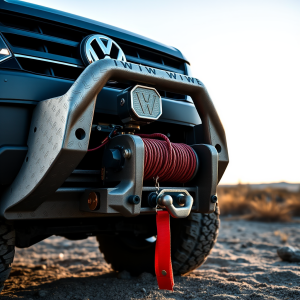Overlooking the importance of a front winch on your 4×4 could leave you stranded in challenging terrain when you least expect it. Whether you’re tackling steep muddy inclines or navigating through deep sand, a reliable winch serves as your ultimate recovery tool. As your off-road adventures become more ambitious, you’ll quickly discover that self-recovery capabilities aren’t just convenient – they’re imperative for your safety and peace of mind. This comprehensive guide will walk you through everything you need to know about selecting, installing, and utilizing a front winch for your off-road vehicle.

Winch Essentials
Before plunging into winch selection, you’ll need to understand the fundamental components that make up a reliable winch system. Your winch setup should include a mounting plate, fairlead, remote control, and safety equipment such as tree trunk protectors and D-shackles. These components work together to ensure safe and effective recovery operations in challenging off-road situations.
Electric vs. Hydraulic Winches
Essentials of winch power systems come down to two main types: electric and hydraulic. Electric winches are more common for recreational off-roaders, offering easy installation and operation through your vehicle’s electrical system. Your electric winch will provide quick response times and reliable performance for most recovery situations. Hydraulic winches, while more expensive, deliver consistent power and can operate continuously without the risk of overheating – making them ideal if you’re planning extensive recovery operations.
Weight Capacity and Line Selection
An important factor in choosing your winch is understanding the correct weight capacity needed for your vehicle. You’ll want a winch rated at least 1.5 times your vehicle’s gross weight to account for various recovery scenarios and stuck situations. Your choice between synthetic rope and steel cable will impact both performance and safety – synthetic rope is lighter, easier to handle, and safer if it breaks, while steel cable offers better resistance to abrasion and environmental factors.
To maximize your winch’s effectiveness, you’ll need to consider factors like line speed, power consumption, and duty cycle. Your synthetic rope should be regularly inspected for wear and properly maintained, while steel cable requires periodic cleaning and lubrication to prevent rust and ensure smooth operation. Selecting the right combination of capacity and line type will significantly improve your recovery capabilities and overall off-road experience.
Mounting Systems
You have several options when it comes to mounting your winch on your 4×4, and choosing the right system can make a significant difference in both functionality and ease of installation. The mounting location needs to provide solid structural support while ensuring your winch remains accessible and operational in various recovery scenarios. Your choice will largely depend on your vehicle’s make and model, as well as your specific off-roading needs.
Factory Bumper Solutions
Beside standard mounting plates, factory bumper winch mounting solutions offer a cost-effective way to add recovery capability to your vehicle while maintaining its original look. Your factory bumper can often accommodate a winch mount through bolt-on brackets or plates that attach directly to your vehicle’s frame, providing a secure foundation for your winch without requiring extensive modifications.
Aftermarket Bumper Options
Among the most popular choices for serious off-roaders, aftermarket bumpers with integrated winch mounts offer superior strength and versatility. You’ll find these purpose-built bumpers provide better approach angles, additional protection, and often include features like light mounts and recovery points. Your investment in an aftermarket bumper solution can significantly enhance both the functionality and appearance of your 4×4.
Solutions range from minimalist plate bumpers to full-width models with brush guards, giving you the flexibility to choose based on your specific needs and preferences. Your selection should consider factors like weight distribution, compatibility with other accessories, and whether you want additional features such as built-in steps or hi-lift jack points.
Power and Performance
There’s no getting around it – when it comes to 4×4 winches, power and performance specifications are what will determine your recovery success in challenging situations. Your winch needs to have enough pulling capacity to handle not just your vehicle’s weight, but also account for additional factors like mud suction, steep inclines, and recovery angles. This is why understanding the key performance metrics is imperative for selecting the right winch for your off-road adventures.

Motor Types and Ratings
The choice between different motor types can significantly impact your winching performance and reliability. You’ll typically encounter these main varieties:
- Series Wound Motors – Offering high torque and reliable performance
- Permanent Magnet Motors – More compact and efficient for lighter use
- Hydraulic Motors – Delivering consistent power for heavy-duty applications
| Motor Type | Best Application |
| Series Wound | Heavy-duty recovery, frequent use |
| Permanent Magnet | Light to medium duty, occasional use |
| Hydraulic | Industrial/commercial applications |
| Combined Systems | Specialized recovery operations |
Line Pull Specifications
Below are the imperative factors you need to consider when evaluating line pull specifications. Your winch should be rated for at least 1.5 times your vehicle’s gross weight to ensure safe and effective recovery operations. The line speed and power consumption will vary depending on the load being pulled, with the first layer of cable providing maximum pulling power.
Motor specifications directly influence your winch’s pulling capacity and speed. You’ll find that higher amperage ratings generally translate to better pulling power, while the gear ratio affects both speed and torque output. This relationship between power and performance becomes particularly important when you’re dealing with challenging recovery situations or extended winching operations.
Safety Features
To ensure your safety during winching operations, modern 4×4 winches come equipped with multiple built-in safety mechanisms. Your winch’s safety features protect both you and your equipment from potential hazards, including cable breaks, overloading, and mechanical failures. These features work together to create a secure winching environment, allowing you to tackle challenging terrain with confidence.
Braking Systems
At the core of your winch’s safety features lies the braking system, which prevents uncontrolled unwinding and maintains tension during recovery operations. Your winch’s mechanical brake automatically engages when the motor stops, while the dynamic brake provides controlled line release when you need it. These systems work in tandem to give you complete control over the winching process while preventing dangerous cable snapback.
Remote Operations
Systems for remote operation represent one of the most important safety advancements in modern winch technology. Your ability to control the winch from a safe distance significantly reduces the risk of injury during recovery operations. Whether you choose a wired or wireless remote, these systems allow you to maintain clear visibility of the entire winching process while staying out of harm’s way.
Considering the various remote options available, you’ll find that wireless systems offer the greatest flexibility and safety margin. Your wireless remote typically provides a range of 50 feet or more, allowing you to position yourself strategically during recovery operations. Many modern systems also include features like automatic shut-off and emergency stop functions, giving you additional layers of safety control.
Recovery Techniques
After getting stuck in challenging terrain, having the right recovery techniques at your disposal can mean the difference between a minor delay and a major ordeal. Your winch is one of the most versatile recovery tools available, but knowing how to use it safely and effectively is vital for successful off-road adventures.
Basic Winching Methods
One of the first techniques you’ll need to master is straight-line recovery, where your winch line runs directly from your vehicle to a suitable anchor point. Your approach should always begin with a thorough assessment of the situation, ensuring your anchor point is sturdy enough to handle the load and your synthetic rope or steel cable is properly spooled and free from damage.
Basic Winching Equipment Checklist
| Essential Items | Purpose |
| Tree Trunk Protector | Prevents damage to anchor points |
| Shackles | Secure connection points |
| Recovery Gloves | Hand protection during operation |
| Snatch Block | Changes pulling direction and doubles pulling power |
Advanced Recovery Scenarios
One of the most challenging situations you’ll encounter is when your vehicle is stuck at an awkward angle or in deep mud where a straight pull isn’t possible. In these cases, you’ll need to employ more sophisticated techniques like double-line pulls using a snatch block or incorporating a bridle setup for better pulling angles.
- Self-recovery using multiple anchor points
- Side recovery techniques for slope situations
- Double-line pull methods for heavy loads
- Recovery in deep water crossings
And when facing particularly challenging recoveries, you’ll want to consider using advanced equipment like winch extension straps and pulley blocks to create mechanical advantage systems. These setups can significantly increase your pulling power while reducing strain on your winch motor.
Advanced Recovery Equipment Guide
| Specialized Gear | Application |
| Winch Extension Strap | Extends reach to distant anchor points |
| Multiple Snatch Blocks | Creates complex pulling systems |
| Bridle Kit | Distributes load across multiple points |
| Ground Anchor | Creates artificial anchor point |
Maintenance and Care
Unlike many other vehicle accessories, your winch operates in some of the most challenging conditions imaginable. Exposure to mud, water, dust, and extreme temperatures can take a toll on your winch’s performance and longevity. To protect your investment and ensure reliable operation when you need it most, implementing a proper maintenance routine will keep your winch ready for action and extend its service life.
Regular Inspection Points
Regular visual checks of your winch should focus on key components that commonly show wear and tear. You’ll want to examine the wire rope or synthetic line for fraying, kinks, or damage, inspect the fairlead for smooth operation and wear patterns, and check all mounting bolts for proper torque. Your inspection should also include the winch motor’s electrical connections, ensuring they remain clean, tight, and free from corrosion.
Service Schedules
One of the most effective ways to maintain your winch is to follow a structured service schedule based on both time and usage. You should conduct basic maintenance every three months or after each major recovery operation, whichever comes first. This includes cleaning, lubricating moving parts, and checking the gear oil level in the gearbox.
Inspection intervals may need to be adjusted depending on your usage patterns and operating environment. If you frequently use your winch in muddy or saltwater conditions, you’ll benefit from more frequent maintenance checks. During these detailed inspections, pay special attention to the clutch mechanism, brake assembly, and motor brushes, as these components often require earlier replacement in harsh conditions.
Final Words
Following this comprehensive guide, you’ll now understand that a front winch isn’t just another accessory—it’s an crucial tool that transforms your 4×4 experience. Your investment in a quality winch system will pay dividends through enhanced safety, improved recovery capabilities, and the confidence to tackle more challenging terrain. As you prepare your vehicle for off-road adventures, choosing and installing the right winch should be at the top of your modification list.
Your decision to equip your 4×4 with a front winch opens up new possibilities for exploration while ensuring you have a reliable way to overcome obstacles and assist fellow off-roaders. By considering the factors outlined in this guide—from weight capacity to rope type—you’ll be well-equipped to select a winch that perfectly matches your vehicle and off-roading needs. Take the time to practice your winching techniques in a controlled environment, and you’ll be ready to handle whatever challenges the trails throw your way.
